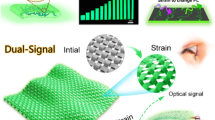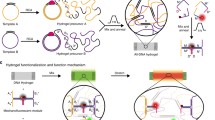Abstract
1,2-Dioxetane is a well-known chemiluminescent mechanophore allowing real-time monitoring of polymer chain scission, but usually suffers from fluorescence quenching in polar environments. Herein, a series of mechanochemiluminescent waterborne polyurethanes/carbon dots composites (WPU-CDs) have been synthesized by incorporating fluorescent CDs to promote the energy transfer process in different environments. The resulting bulk WPUs, and in particular, their swollen films filled with a large amount of polar solvents (water and ionic liquid) emit intense mechanochemiluminescence. Thus force-induced covalent bond scission and stress distribution within these different WPU-CDs films can be sensitively visualized. Furthermore, the ionic liquid containing films exhibited both electrical and luminescent signal changes under stretching, which offer a new kind of force sensor responsive at a broad detecting strain range and for multi-mode strain analysis. This study is expected to stimulate new research endeavors in mechanistic insight on waterborne polyurethanes and the corresponding stretchable sensing devices.
Similar content being viewed by others
References
Honarkar, H. Waterborne polyurethanes: a review. J. Disper. Sci. Technol. 2018, 39, 507–516.
Nelson, A. M.; Long, T. E. Synthesis, properties, and applications of ion-containing polyurethane segmented copolymers. Macromol. Chem. Phys. 2014, 215, 2161–2174.
Song, Y.; Gao, Y.; Pan, Z.; Zhang, Y.; Li, J.; Wang, K.; Li, J.; Tan, H.; Fu, Q. Preparation and characterization of controlled heparin release waterborne polyurethane coating systems. Chinese J. Polym. Sci. 2016, 34, 679–687.
Yang, N.; Yang, H.; Shao, Z.; Guo, M. Ultrastrong and tough supramolecular hydrogels from multiurea linkage segmented copolymers with tractable processablity and recyclability. Macromol. Rapid Commun. 2017, 38, 1700275.
Sun, J.; Keplinger, C.; Whitesides, G. M.; Suo, Z. Ionic skin. Adv. Mater. 2014, 26, 7608–7614.
Li, T.; Wang, Y.; Li, S.; Liu, X.; Sun, J. Mechanically robust, elastic, and healable ionogels for highly sensitive ultra-durable ionic skins. Adv. Mater. 2020, 32, 2002706.
Kim, N.; Lienemann, S.; Petsagkourakis, I.; Mengistie, D. A.; Kee, S.; Ederth, T.; Gueskine, V.; Leclere, P.; Lazzaroni, R.; Crispin, X.; Tybrandt, K. Elastic conducting polymer composites in thermoelectric modules. Nat. Commun. 2020, 11, 1424–1433.
Chen, Y.; Mellot, G.; van Luijk, D.; Creton, C.; Sijbesma, R. P. Mechanochemical tools for polymer materials. Chem. Soc. Rev. 2021, 50, 4100–4140.
Davis, D. A.; Hamilton, A.; Yang, J.; Cremar, L. D.; Van Gough, D.; Potisek, S. L.; Ong, M. T.; Braun, P. V.; Martínez, T. J.; White, S. R.; Moore, J. S.; Sottos, N. R. Force-induced activation of covalent bonds in mechanoresponsive polymeric materials. Nature 2009, 459, 68–72.
Wang, L.; Yang, K.; Zhou, Q.; Yang, H.; He, J.; Zhang, X. Rhodamine mechanophore functionalized mechanochromic double network hydrogels with high sensitivity to stress. Chinese J. Polym. Sci. 2020, 38, 24–36.
Chen, Y.; Spiering, A. J. H.; Karthikeyan, S.; Peters, G. W. M.; Meijer, E. W.; Sijbesma, R. P. Mechanically induced chemiluminescence from polymers incorporating a 1,2-dioxetane unit in the main chain. Nat. Chem. 2012, 4, 559–562.
Chen, Y.; Sijbesma, R. P. Dioxetanes as mechanoluminescent probes in thermoplastic elastomers. Macromolecules 2014, 47, 3797–3805.
Liu, S.; Yuan, Y.; Li, J.; Sun, S.; Chen, Y. An optomechanical study of mechanoluminescent elastomeric polyurethanes with different hard segments. Polym. Chem. 2020, 11, 1877–1884.
Yan, C.; Yang, F.; Wu, M.; Yuan, Y.; Chen, F.; Chen, Y. Phase-locked dynamic and mechanoresponsive bonds design toward robust and mechanoluminescent self-healing polyurethanes: a microscopic view of self-healing behaviors. Macromolecules 2019, 52, 9376–9382.
Yuan, W.; Yuan, Y.; Yang, F.; Wu, M.; Chen, Y. Improving mechanoluminescent sensitivity of 1,2-dioxetane-containing thermoplastic polyurethanes by controlling energy transfer across polymer chains. Macromolecules 2018, 51, 9019–9025.
Deng, Y.; Yuan, Y.; Chen, Y. Covalently cross-linked and mechanochemiluminescent polyolefins capable of self-healing and self-reporting. CCS Chem. 2020, 2, 1316–1324.
Ducrot, E.; Chen, Y.; Bulters, M.; Sijbesma, R. P.; Creton, C. Toughening elastomers with sacrificial bonds and watching them break. Science 2014, 344, 186–189.
Millereau, P.; Ducrot, E.; Clough, J. M.; Wiseman, M. E.; Brown, H. R.; Sijbesma, R. P.; Creton, C. Mechanics of elastomeric molecular composites. Proc. Natl. Acad. Sci. U.S.A. 2018, 115, 9110–9115.
Chen, W.; Yuan, Y.; Chen, Y. Visualized bond scission in mechanochemiluminescent polymethyl acrylate/cellulose nanocrystals composites. ACS Macro Lett. 2020, 9, 438–442.
Clough, J. M.; Creton, C.; Craig, S. L.; Sijbesma, R. P. Covalent bond scission in the mullins effect of a filled elastomer: real-time visualization with mechanoluminescence. Adv. Funct. Mater. 2016, 26, 9063–9074.
Yuan, Y.; Chen, W.; Ma, Z.; Deng, Y.; Chen, Y.; Chen, Y.; Hu, W. Enhanced optomechanical properties of mechanochemiluminescent poly(methyl acrylate) composites with granulated fluorescent conjugated microporous polymer fillers. Chem. Sci. 2019, 10, 2206–2211.
Matsumoto, M. Advanced chemistry of dioxetane-based chemiluminescent substrates originating from bioluminescence. J. Photochem. Photobiol. C 2004, 5, 27–53.
Yang, F.; Yuan, Y.; Sijbesma, R. P.; Chen, Y. Sensitized mechanoluminescence design toward mechanically induced intense red emission from transparent polymer films. Macromolecules 2020, 53, 905–912.
Yan, F.; Sun, Z.; Zhang, H.; Sun, X.; Jiang, Y.; Bai, Z. The fluorescence mechanismof carbon dots, and methods for tuning their emission color: a review. Microchim. Acta 2019, 186, 583.
Baker, S. N.; Baker, G. A. Luminescent carbon nanodots: emergent nanolights. Angew. Chem. Int. Ed. 2010, 49, 6726–6744.
Du, X.; Wang, C.; Wu, G.; Chen, S. The rapid and large-scale production of carbon quantum dots and their integration with polymers. Angew. Chem. Int. Ed. 2021, 60, 8585–8595.
Lim, S. Y.; Shen, W.; Gao, Z. Carbon quantum dots and their applications. Chem. Soc. Rev. 2015, 44, 362–381.
Liu, J.; Li, R.; Yang, B. Carbon dots: a new type of carbon-based nanomaterial with wide applications. ACS Cent. Sci. 2020, 6, 2179–2195.
Liu, M.; Chen, B.; Li, C.; Huang, C. Carbon dots: synthesis, formation mechanism, fluorescence origin and sensing applications. Green Chem. 2019, 21, 449–471.
Qiang, T.; Han, M.; Wang, X. Waterborne polyurethane/carbon quantum dot nanocomposite as a surface coating material exhibiting outstanding luminescent performance. Prog. Org. Coat. 2020, 138, 105433.
Tsuda, R.; Kodama, K.; Ueki, T.; Kokubo, H.; Imabayashi, S.; Watanabe, M. LCST-type liquid-liquid phase separation behaviour of poly(ethylene oxide) derivatives in an ionic liquid. Chem. Commun. 2008, 4939–4941.
Jiang, K.; Sun, S.; Zhang, L.; Lu, Y.; Wu, A.; Cai, C.; Lin, H. Red, green, and blue luminescence by carbon dots: full-color emission tuning and multicolor cellular imaging. Angew. Chem. Int. Ed. 2015, 54, 5360–5363.
Shen, C.; Lou, Q.; Lv, C.; Zang, J.; Qu, S.; Dong, L.; Shan, C. Bright and multicolor chemiluminescent carbon nanodots for advanced information encryption. Adv. Sci. 2019, 6, 1802331.
Zheng, A.; Guo, T.; Guan, F.; Chen, X.; Shu, Y.; Wang, J. Ionic liquid mediated carbon dots: preparations, properties and applications. Trac-trend Anal. Chem. 2019, 119, 115638.
Liu, Y.; Liu, D.; Li, S.; Liang, H.; Zhu, F. Investigation on viscoelasticity of waterborne polyurethane with azobenzene-containing pendant groups under ultraviolet and visible-light irradiation. Chinese J. Polym. Sci. 2019, 37, 1267–1272.
Zhang, Q.; Wang, Y.; Xing, C.; Cai, Y.; Xi, K.; Jia, X. Light and force dual-responsive waterborne polyurethane in multiple states. RSC Adv. 2017, 7, 12682–12689.
Acknowledgments
This work was financially supported by the National Natural Science Foundation of China (Nos. 21905200, 21975178 and 21734006), and China Postdoctoral Science Foundation (No. 2019M661006).
Author information
Authors and Affiliations
Corresponding authors
Electronic Supplementary Information
Rights and permissions
About this article
Cite this article
Cao, BH., Chen, W., Wei, WY. et al. Carbon Dots Intensified Mechanochemiluminescence from Waterborne Polyurethanes as Tunable Force Sensing Materials. Chin J Polym Sci 39, 1403–1411 (2021). https://doi.org/10.1007/s10118-021-2601-4
Received:
Accepted:
Published:
Issue Date:
DOI: https://doi.org/10.1007/s10118-021-2601-4




